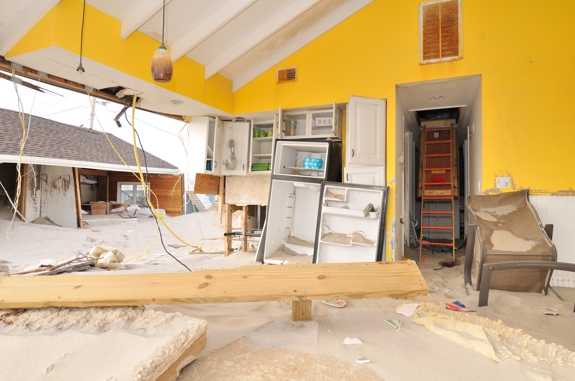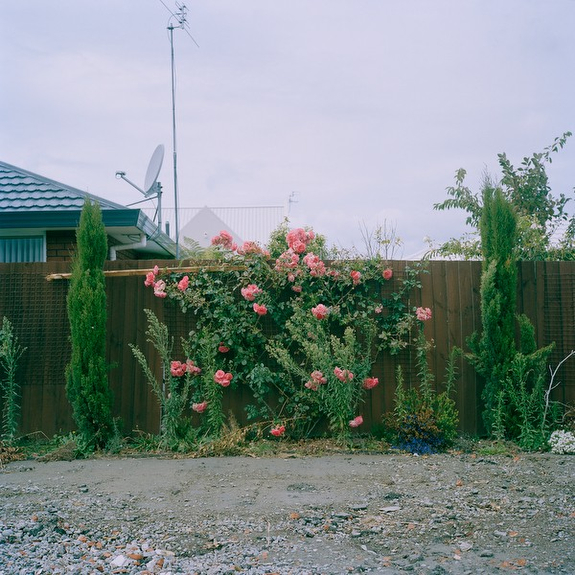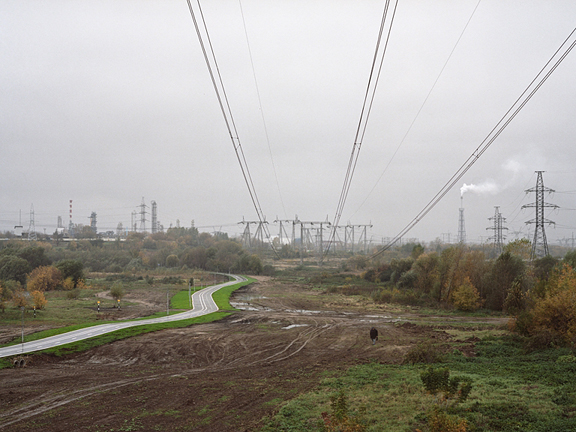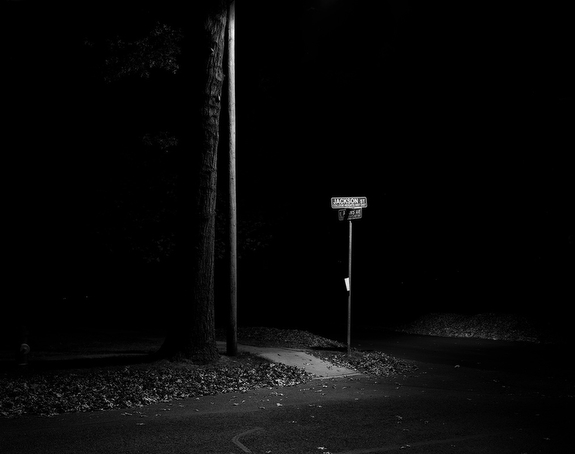
www.DouglasLjungkvist.com
How did you come to be interested in fine-art photography ??
Well, I started photographing almost nine years ago and was pretty much hooked right away. But it took some exploring to learn what type of photography I was interested in. Stephen Shore’s book Uncommon Places, before I had any idea who he was, was a confirmation that one could photograph (uncommon) places and the vernacular. I learned over time that how something looks and feels is more important than what it depicts. That pretty much ruled out most other types of photography (for personal work), which was fine with me, as I see photography as a form of self expression. If I could paint, chances are I would be a painter, too, or a writer.
How do you identify and develop a project ??
It starts with place for me. By that I mean location(s), environments, private or public, places with names. I’m interested in how and where we live, but more so in the place itself, than the people that live there now. I think it stems back to my interest in geography and history in school and having traveled extensively since a very young age. My process includes going back to places over and over so it’s important that I like spending time there, or be really curious about them.
I had visited and vacationed at Ocean Beach several times before I started my project there. But I had not been there for 10 years when I went back to scout and started shooting. I have photographed in Brooklyn since 2007. Mostly around the industrial areas as Park Slope, where I live, is too ornate, full of people, trees, and cars —- things I seldom include in my photographs. Middletown USA is really the only body of work so far, and my first long-term project, that I had not visited before I started photographing it. I was driven by curiosity how different 16 towns in 16 states that share a name, Middletown, would look. And I wanted to experience small-town USA and photograph outside my urban comfort zone.
Please tell us a bit about your Ocean Beach project. What forms has it taken ??
I started by photographing the architectural landscape in the off-season. I loved the process of walking up and down rows and rows of cottages looking for visceral subject matters. Sometimes I could go all day without seeing a person. After a while I contacted the rental agency for permission to photograph inside the cottages. To my surprise they said yes. Being interested in places stuck in time, especially the 70’s, I was disappointed to learn how many of the cottages had been renovated to be more attractive on the competitive rental market, from when I had vacationed there in the 90’s. But with more than 2,000 cottages there were still enough that interested me.
About 2/3rds of the way through the project I started adding some personal items to select cottage interiors. I wanted to create these fragmented self portraits what I might have looked like had I grown up spending summers at Ocean Beach. The project was scheduled for publication in the spring of 2013. But of course the timeline was thrown off after Superstorm Sandy. Ocean Beach was hit really hard. More than 90% of the cottages facing the ocean were destroyed. Many on/between the bay and ocean-sides were destroyed, too. My initial reaction was that I didn’t want to photograph the aftermath. I have never liked how post-disaster photographs look with all its debris and disorder. Another concern was that it might look too documentary or like it was made by another photographer. I think not having access to the thin barrier island for a couple of months helped change my mind about resuming the work. I still didn’t think I wanted to include the post-storm work in the book though.
After a few visits it was clear that the post-storm work could co-exist visually. But we didn’t want it to take away from the older work in the book so we solved it by adding a separate section with its own introduction. It wasn’t until after Sandy that I started including photographs of the ocean and beach, which after all is what the place and book is called, Ocean Beach. It felt appropriate as the ocean and sand had contributed to so much of the destruction. I went back often to photograph the demolition and beginning of the reconstruction process. My solitary work process was gone and things were changing very quickly. Looking back, I think it made the book deeper with the context and contrast of having documented a natural disaster area long before the catastrophic event. Since the book came out I’ve been back a half dozen times checking on the reconstruction. I find it hard to stay away for too long.
How did you develop a relationship with Kehrer Verlag ?? Any advice for artists looking to publish books ??
I made a mock-up every now and then, using Blurb, and forwarded a preview link to a few publishers that were on my wish-list. Kehrer Verlag was the publisher that showed the most interest and always offered feedback. Luckily for me they were on top of my wish list. So when their acquisitions director was reviewing portfolios at the CONTACT Festival in Toronto I decided to go. Having only seen the work on screen she really liked the prints and said that she wanted to publish the project. But it was still up to the owner to green-light it of course. But she must have done a good sales pitch because shortly after I learned that we were in business.
In terms of finding a publisher, I would try to resist the temptation to show work that is not nearing publication or at least has a clearly defined outline. The risk being that it can be difficult to get a publisher, or anyone for that matter, to look at a project (again) if they have formed an opinion early on. Most important, research publishers and target ones that publish books similar in nature to yours. Learn who the decision makers are. Try and include them in your marketing efforts. Ask other photographers who have already published books with them what the experience was like and what to expect. Meeting the publisher at a portfolio review might be your best bet to get your work in front of them. If so, bring a book mock-up in addition to your portfolio prints. Oh, and make sure you have a big bag of money saved up. Expect to contribute to the books production cost in the area of $15-20,000 for a top-quality publisher with international distribution.
What’s your next project ??
I have several in mind. I want to get back to work on Middletown USA. I hope to do that during several extended road trips starting this fall. Hopefully I can get a grant or fellowship to make that happen financially. I have a couple of project ideas in my homeland of Sweden, too, and there’s a nude project in the back of my mind. I have some conceptual and studio/still life ideas, too. I would want to do something in Pennsylvania in the future. I love how its small towns look and its working-class history: gritty, melancholy, and stuck in time and economic change. I think urban landscape photography will always be a part big part of my photography.
Your work is not currently for sale as prints. Could you please explain why that is ??
Though none of my work is available for sale now I will probably make Urban Cars available first. But with other bodies I like the idea to release prints after a book release. But I don’t have any immediate distribution plans for Ocean Beach. Many reasons why. The natural progression would be to secure gallery representation. Based on today’s model I’m not even sure I could afford that, especially in several markets. I don’t believe in the direct sales model even though there are several good platforms, unless you’re famous or have a large following (I’m 0 for 2). I’m playing with the idea of selling work in editions of one print, or only as a series of prints. I know these ideas are probably not feasible, especially for an artist not that well known yet. I don’t hate the idea of leaving the work for my daughter either, to sell after I’m gone. Perhaps a few decades will increase its value and demand, too. But until I know which way I’m going, I’d rather hold off.
How helpful do you find social media in your practice as a photographer ??
Very helpful, no doubt. I have a fairly small social media network compared to many other photographers. But online in general has been very helpful to get my work exposed the last several years, blogs, magazines, etc. And several Facebook groups that I belong to have proven very valuable in connecting with other photographers. But I have downsized my online presence in the last year. I used to post a photo a day on Facebook. The second half of last year I reduced that to 2-3 a week in a “less is more” exercise. And I pretty much restrict it now to my typology Urban Cars. Sometimes I get in trouble online for being too opinionated or saying how I really feel. Now I’m trying (hard) not to say anything, unless I have something nice to say. I know some folks are looking to get a reaction out of you and too often I take the bait. People generally find me more pleasant in real life.
I often find myself doing the opposite of what the majority is doing. So when so many photographers are posting so much in so many places it kind of feels right to do less. My work needs to be strong enough that it can survive despite not being top of mind everywhere all the time. Besides I like the idea of slow and steady leading to longevity as opposed to trending. As part of my online strategy I don’t belong to Instagram, Flickr, or Tumblr and I’m not very active on Twitter either.
How do you see the future of photography, including your own ??
It seems to me that we’re going through a period of short-term trends. The medium and its critics, curators, and tastemakers all seem to be searching for what’s next. Right now abstract and conceptual is big. Perhaps it’s also to more clearly define and separate the artists from the non-professional photographers considering the enormous amount of photographs being made and looking for viewers. Looking back it’s kind of funny how digital photography was going to ruin photography. And in retrospect the film vs. digital discussion and impact turned out to be pretty minimal compared to smartphone photography and social media.
I spend very little time looking at contemporary photography except what I see on a few favorite online magazines and blogs. I live in a bit of a bubble. Movies, not photographs, are by far my biggest sources of inspiration. And not even so much the cinematography as the overall art direction, mood and atmosphere created by location, time of year, shooting, and light. I’m going through a period of re-watching Italian neo-realism movies now. As for my personal photographic future, in an ideal world, I would like to see 50% of my income come from personal projects and the rest from editorial and commercial work. Commissions would be the ultimate way of working for me and I would love to teach some workshops, too.
How has photography changed you as a person?
It’s changed me tremendously. When I photograph is pretty much the only time that I’m not affected by sometimes disruptive OCD and ADD. So from that perspective it’s therapeutic. Though I don’t photograph people that often it has also changed how I interact with people. When I started out I was very defensive even hostile at times when people would approach me about what I was photographing or why. Coming home from a portfolio shoot in the Dominican Republic I had all these stories about people I met and engaged with and my wife pointed out how I had turned a corner in how I was communicating with people. Now if someone approaches me in an aggressive manner we almost always part on friendly terms.
Photography has also taught me to trust my instincts and grow my confidence. Almost all hobbies or interest I’ve had in the past, and even in my previous business career, I was never the most confident person. I was often better than average but never really stood out or excelled. At times I could feel intimidated, especially by authority. Where a colleague might be excited to run into the boss and have a chat I would take a detour to avoid them.
With photography it’s different. Sure, it’s easier to be confident about something that is subjective. But having found my photographic voice and receiving some praise and accolades along the way has given me the confidence that an artist, or anyone for that matter, needs to be successful. I’m almost more embarrassed by praise than the hurt of criticism, but I’m working on that. Regardless how I compare to others, I have found what I do better than anything else that I have ever engaged in. Being a middle aged, self-taught white dude, from the digital revolution might not be the ideal platform to start from, but with my newfound confidence and the fact that I’m still growing as an artist makes me feel very good about me and photography having a future together.
Is there anything else you’d like to say ??
I would not recommend my online strategy to a photographer just starting out. They need to be in as many places as possible. I would probably not recommend it to someone in my shoes either. But doing what suits your personality is important to me. I come from a culture where self promotion is considered in poor taste. I’ve always said; if I’m “going to make it” it’s going to be based on the strength of my work, not who I know, not my personality, or how popular I am. However, deep down, I don’t think it is only about the work.
— Interview conducted and edited by Willson Cummer































